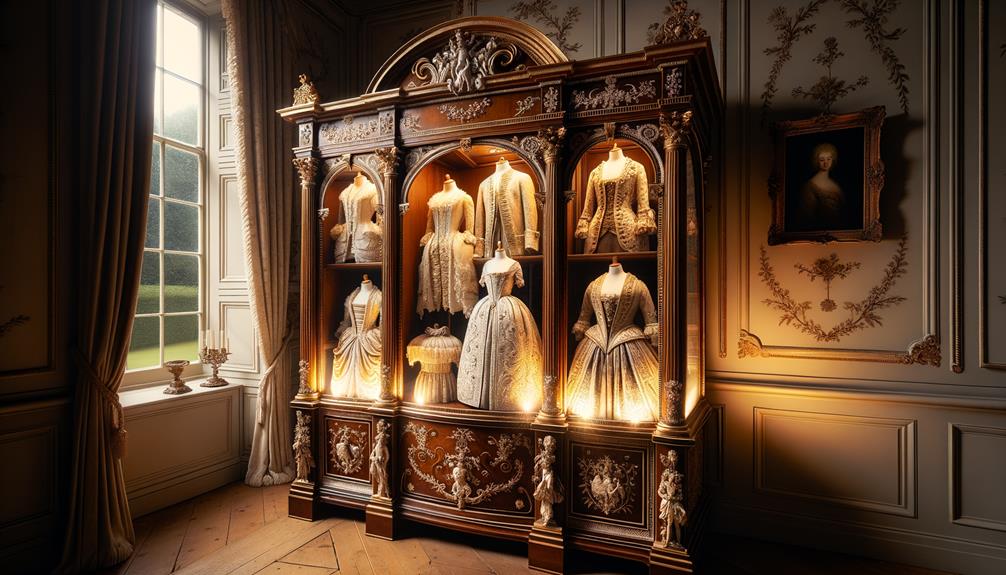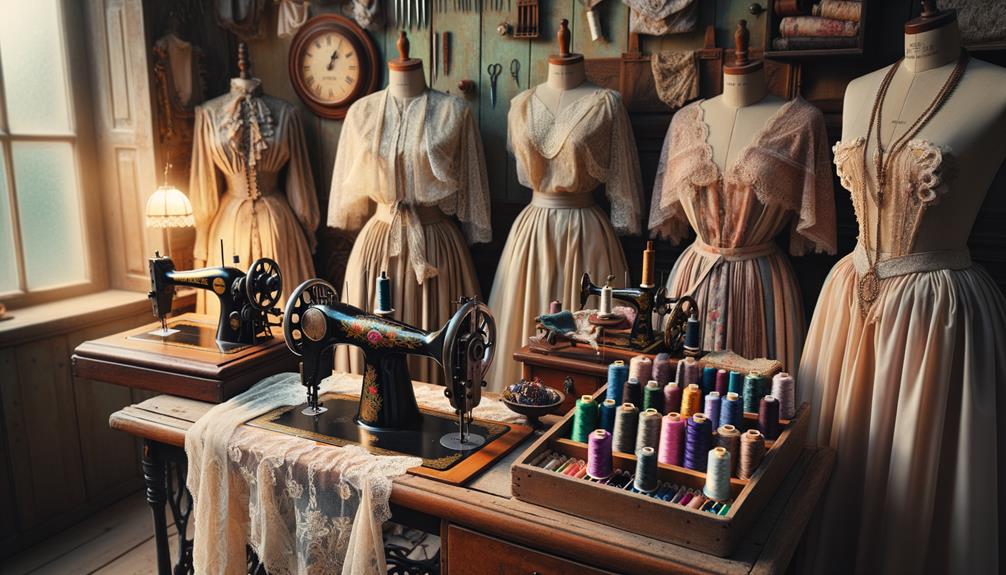Preserving fashion heritage is crucial because it safeguards our cultural identity, history, and artistry. Traditional garments are more than just clothes; they're vessels carrying the stories and expertise of skilled artisans. Each piece connects us to a shared past and guides us toward a more inclusive future. It's about honoring those who came before us and maintaining a delicate balance between innovation and tradition. By protecting these garments, we're not just preserving fabric, but the essence of who we are and what we value as a society. Exploring this rich tapestry can inspire and shape our cultural evolution.
Cultural Significance
Fashion heritage is much more than just clothes; it's a tapestry that reflects our cultural identity, history, and personal stories. When I think about traditional clothing, I see beyond the fabric and patterns – each piece carries a narrative woven by artisans who've honed skills passed down through generations. This heritage isn't just preserved in museums; it's alive in the hands of those who continue to craft these textiles with meticulous care.
Preserving these traditions means safeguarding our cultural identity. It's about honoring the artisans whose work embodies the essence of our heritage. In an ever-changing fashion industry, it's easy to overlook the value of these traditional garments. Yet, they hold the key to understanding our roots and the diverse cultures that shape our world.
As we innovate and push the boundaries of fashion, we mustn't forget the importance of preserving our heritage. The knowledge embedded in these textiles offers insights into our collective past and provides a foundation upon which we can build a more inclusive future. By embracing the cultural significance of traditional clothing, we guarantee that the rich tapestry of our history continues to inspire and inform us.
Historical Insights
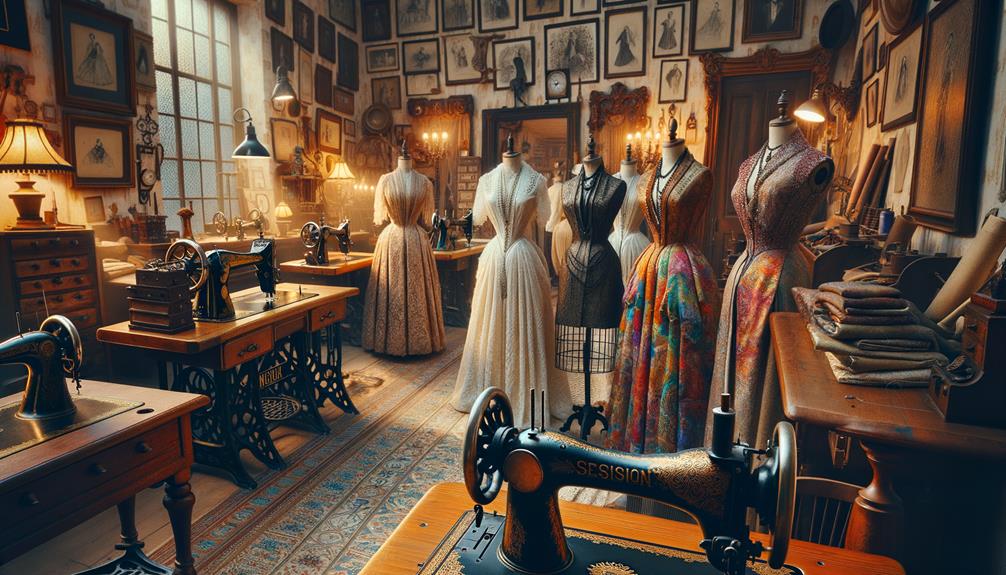
Reflecting on the cultural significance of traditional clothing, it's fascinating to uncover the insights these garments reveal about our ancestors' lives. Each stitch and fabric choice provides a window into the past, highlighting the richness of our cultural heritage passed down through generations.
Traditional garments are more than just clothing; they're woven with stories and cultural symbols. By studying them, I've discovered how artisans and communities expressed their identities and values. Here are some key insights:
- Symbolism: Traditional designs often incorporate specific motifs that represent spiritual beliefs or social status.
- Materials: The choice of fabric and dye reflects the natural resources available to a community and their trade relationships.
- Techniques: Craftsmanship techniques, passed down through generations, showcase the skill and innovation of artisans.
- Evolution: Changes in garment styles over time illustrate historical events and shifts in cultural attitudes.
Preserving these traditional garments is essential. They are living artifacts that connect us to our roots and inform our future innovations. By examining these pieces, we honor the legacy of the artisans and communities that shaped our history.
Conservation Challenges
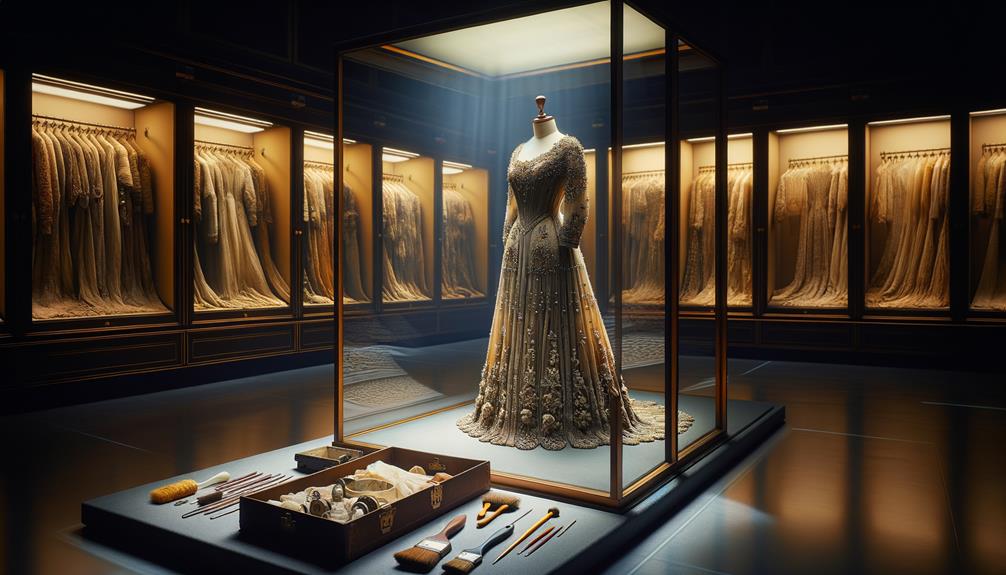
Preserving traditional garments involves navigating a complex web of environmental, technological, and ethical challenges. Balancing the preservation and promotion of cultural heritage while adapting to sustainable production methods is a delicate dance, especially when local artisans face dwindling resources and outdated techniques.
One of the most significant challenges is ensuring traditional attire is produced responsibly. Fashion designers must be mindful of cultural appropriation, respecting and honoring the origins of the garments they draw inspiration from. This respect is essential in fostering a genuine connection to cultural heritage.
The environmental impact of fashion is also a crucial consideration. Sustainable production methods are vital, but implementing them without compromising the authenticity of traditional garments is a significant challenge. Local artisans, the stewards of these traditions, need support and innovation to keep their crafts alive in an ever-changing market.
Preservation Efforts
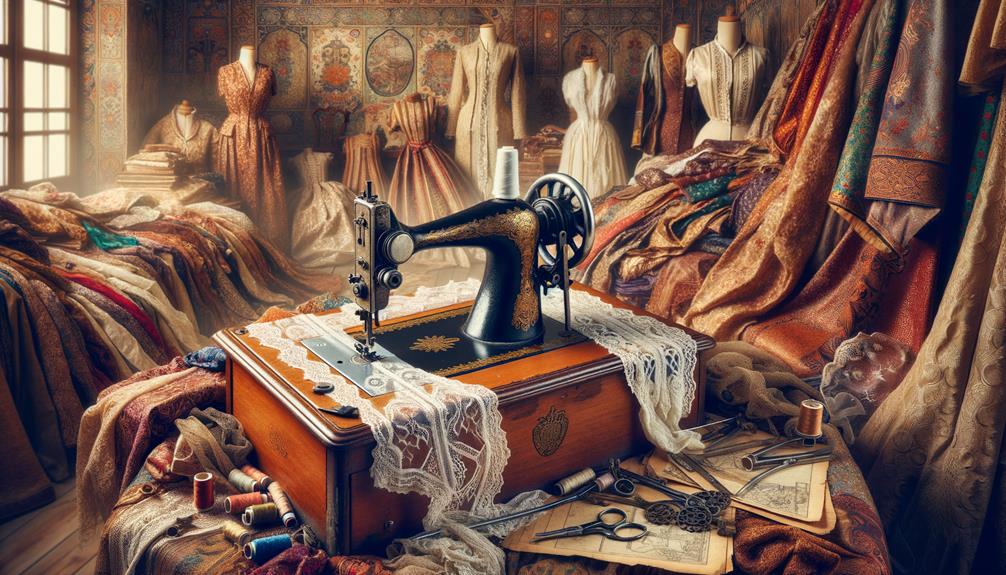
Museums and cultural institutions play a crucial role in preserving historical garments and safeguarding their stories for the future. These preservation efforts are essential for maintaining our cultural heritage and understanding the rich history and significance embedded in every stitch of clothing.
Some key initiatives in fashion preservation include:
- Specialized Conservation Labs: These labs use acid-free materials to stabilize fragile textiles, ensuring that 19th-century silk gowns and traditional African fashion pieces are protected for generations to come.
- Digitization Projects: By creating high-resolution archives, institutions provide global access to rare fashion pieces. This reduces physical handling and allows for in-depth study of our global fashion legacy.
- Academic Partnerships: Collaborations between fashion houses and academic institutions drive research on innovative preservation methods, further safeguarding couture collections and facilitating cultural exchange.
- Crowd-sourced Funding: Small museums, often the keepers of cherished community garments like African textiles, rely on these campaigns to undertake critical restoration work.
These preservation efforts weave a rich tapestry of cultural exchange and global fashion history, ensuring that the stories told through garments, from traditional African attire to haute couture, continue to inspire and educate future generations.
Role of Consumers
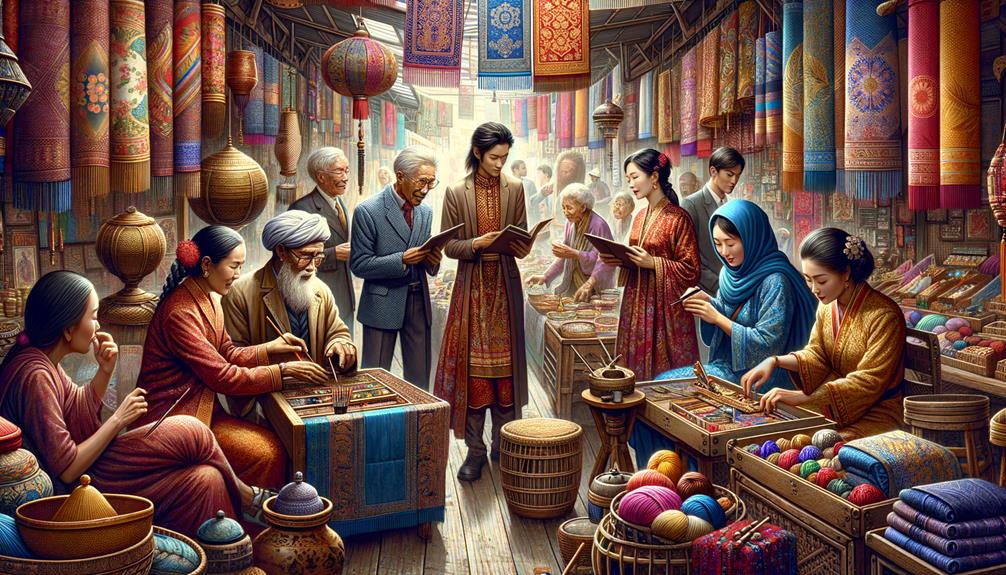
As consumers, our choices have a profound impact on the longevity and appreciation of fashion heritage. When we buy vintage pieces or support artisans creating traditional garments, we're not just preserving fabric – we're safeguarding the stories, craftsmanship, and cultural significance behind them for future generations.
Our decisions speak volumes. By purchasing vintage or supporting local artisans, we're making a statement that we value the history and artistry embedded in these garments. It's a commitment to ensuring fashion heritage isn't lost amidst the constantly changing trends.
Here's a table that highlights our role as consumers:
| Action | Impact | Outcome |
|---|---|---|
| Buying vintage | Reduces waste, supports heritage | Longevity of traditional styles |
| Supporting artisans | Encourages traditional craftsmanship | Sustains cultural significance |
| Educating ourselves | Raises awareness | Informed and respectful choices |
| Repairing clothes | Reduces consumption | Preservation of garments |
| Donating quality items | Extends garment lifespan | Benefits future generations |
Global Perspectives
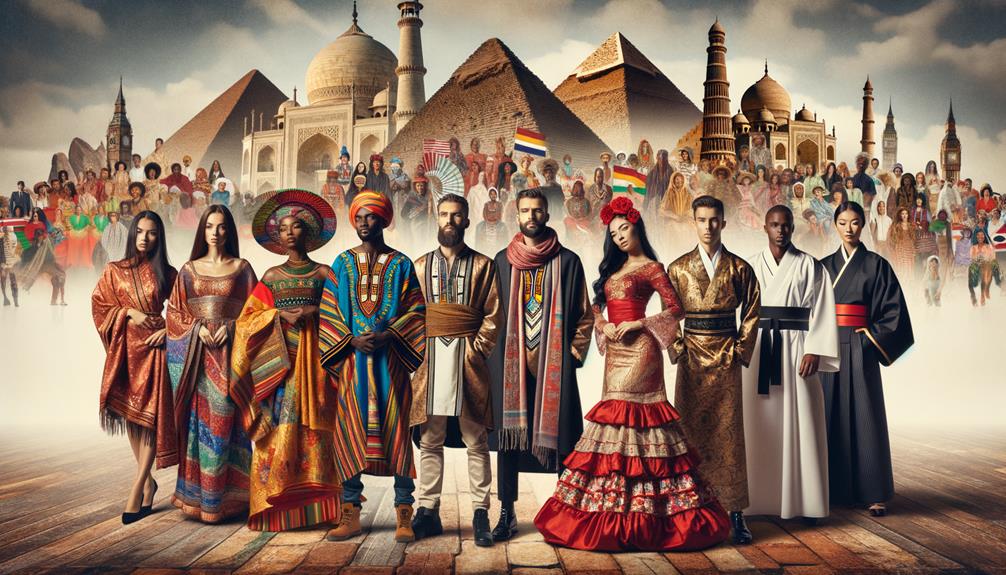
As I reflect on the global journey of fashion, I'm struck by how preserving cultural identity breathes life into traditional techniques. The intricate embroideries of India or the weaving patterns of Peru aren't just crafts; they're stories. Embracing these diverse perspectives enriches our shared heritage, reminding us that fashion is a tapestry of histories from around the world.
The embroideries and weaving styles of different cultures aren't just technical skills – they hold deeper meaning and significance. By celebrating these global influences, we can gain a richer understanding of the human experience woven into the clothes we wear. Fashion isn't just about trends; it's a window into the shared narratives that connect us as a global community.
Cultural Identity Preservation
Fashion isn't just about what people wore; it reveals who they were and the values they held. When I think about cultural identity, I see how deeply it's connected to our heritage. Take traditional African garments, for instance. They're not just fabrics or patterns; they're stories of history and significance, passed down through generations. These garments inspire modern fashion brands to blend time-honored traditions with contemporary innovation.
Consider these points:
- Cultural Roots: Fashion often reflects the rich history of a community, showcasing its unique journey and evolution.
- Identity: Wearing traditional clothing can be a powerful statement of one's cultural identity, connecting individuals to their ancestors.
- Inspiration: Modern designers draw inspiration from historical garments, creating pieces that honor the past while pushing boundaries.
- Preservation: By incorporating traditional elements, fashion brands play a vital role in preserving and promoting cultural heritage.
This blend of old and new ensures our cultural identity remains vibrant and relevant. Fashion becomes an evolving narrative, a lasting record of where we've been and a guide for the future. It's not just about looking back; it's about shaping the future with respect for our roots.
Traditional Techniques Revival
Embracing our cultural identity through fashion naturally leads me to examine how traditional techniques are being revived around the world. Indigenous communities are breathingvital life into traditional textile production, ensuring that handloom weaving, embroidery, and natural dyeing remain vibrant aspects of our shared cultural heritage, rather than lost arts.
In India, organizations like the Self-Employed Women's Association (SEWA) play a key role. They empower marginalized women by training them in traditional handloom weaving and embroidery, and providing market access and financial support. This not only preserves cultural heritage but offers sustainable alternatives to mass-produced fashion.
Latin American designers are embracing ancestral Andean techniques, collaborating with indigenous artisans to weave these rich traditions into contemporary fashion. This fosters cultural appreciation while creating economic opportunities for the artisans.
Similarly, the Maasai people of East Africa are reviving their iconic shuka fabric, using handwoven cotton and natural dyes. This asserts their cultural identity and generates sustainable livelihoods.
In the United States, Native American designers reclaim heritage through Navajo weaving and Pueblo pottery, crafting fashion that honors their roots and challenges the appropriation of indigenous designs.
These global initiatives highlight how traditional techniques can drive innovation, sustainability, and cultural pride in the fashion industry.
Frequently Asked Questions
Why Is Preserving Cultural Heritage Important?
Preserving cultural heritage is crucial because it roots us in our past, sparking future creativity and fostering a sense of identity. Without it, we'd lose the unique stories that shape innovation and drive meaningful progress.
Our cultural heritage reflects the diverse experiences and traditions that have made us who we are. Preserving it allows us to honor the narratives of our ancestors and pass them on to future generations. This connection to the past inspires new ideas, art, and ways of living that build upon our shared histories.
Moreover, cultural heritage preservation fosters a stronger sense of community and belonging. When we celebrate the traditions, artifacts, and stories that define our communities, we cultivate a deeper understanding and appreciation for one another. This shared identity can unite people, transcending differences and promoting social cohesion.
Ultimately, safeguarding our cultural heritage is essential for maintaining our unique identities, fueling creativity, and fostering a more inclusive, interconnected world. By preserving the stories that have shaped us, we can ensure that our rich tapestry of human experience continues to evolve and inspire.
How Does Fashion Preserve Culture?
Fashion acts as a living repository, preserving cultural traditions, stories, and values in every garment. When I wear traditional attire, I feel a profound connection to my roots and am inspired to create innovative interpretations. Fashion allows us to celebrate and preserve the rich tapestry of our cultural heritage, passing it on to future generations.
Why Is Fashion History Important?
Fashion history is captivating because it reveals how our identities, values, and aspirations have evolved over time. Understanding past styles inspires me to innovate, blending tradition with fresh ideas to create something uniquely forward-thinking. It's a dialogue between eras, allowing us to build upon the past while shaping the future. Immersing myself in fashion's rich tapestry gives me a deeper appreciation for the craft and the cultural significance behind the clothes we wear. By exploring how clothing has shifted alongside societal changes, I gain insights that I can apply to my own creative process, pushing the boundaries of what's possible in fashion.
Why Is Culture Important in Fashion?
Culture is essential in fashion because it shapes our identity and sparks innovation. When I wear something with cultural significance, I feel connected to history and inspired to blend tradition with modernity, creating something uniquely my own. Fashion is a way for us to express our cultural heritage and personal style. By incorporating cultural elements into our outfits, we can celebrate diverse backgrounds and inspire others to do the same. Fashion is not just about trends – it's a means of self-expression and a reflection of our values and experiences. The clothes we choose to wear can be a powerful statement about who we are and where we come from.
Conclusion
Preserving fashion heritage is like holding onto a beloved family heirloom. Its value transcends time. Reflecting on its cultural significance, historical insights, and the various challenges of conservation, I realize how crucial these efforts are. We mustn't underestimate the role consumers play or the diverse global perspectives involved. In safeguarding these treasures, we're not just protecting fabric and thread; we're preserving the soul of our collective identity. Let's cherish and nurture this legacy for future generations.



